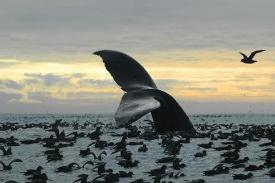 President Obama designated the pristine waters of Bristol Bay as off limits to oil and gas leasing in what amounted to second major win for conservationists on Capitol Hill in a week. The action safeguards one of the nations most productive fisheries and preserves an ecologically rich area of the Bering Sea off the coast of Alaska that is vital to commercial fishing, the outdoor recreation economy and Alaska’s native communities.
President Obama designated the pristine waters of Bristol Bay as off limits to oil and gas leasing in what amounted to second major win for conservationists on Capitol Hill in a week. The action safeguards one of the nations most productive fisheries and preserves an ecologically rich area of the Bering Sea off the coast of Alaska that is vital to commercial fishing, the outdoor recreation economy and Alaska’s native communities.
On Friday, Congress passed the largest public lands bill in roughly six years. That bill also withdrew hundreds of thousands of acres from mineral development across the West in addition to protecting more than 250,000 acres as wilderness, expanding more than a dozen national parks and protecting 140 miles of rivers.
Bristol Bay is at the heart one of the worlds most valuable fisheries, helping to provide 40 percent of Americas wild-caught seafood and support a $2 billion annual fishing industry. The beautiful and remote area is also an economic engine for tourism in Alaska, driving $100 million in recreational fishing and tourism activity every year. Bristol Bay hosts the largest runs of wild sockeye salmon in the world, and provides important habitat for many species, including the threatened Stellars eider, sea otters, seals, walruses, Beluga and Killer whales, and the endangered North Pacific Right Whale.
Todays decision to withdraw the area from all future oil and gas leasing extends indefinitely a temporary withdrawal that President Obama issued in 2010 and was set to expire in 2017. This action d organizations, as well as local seafood and tourism businesses that create jobs and strengthen Alaska and the nations economy. It also honors the legacy of Alaska residents like Harold ‘Harvey Samuelsen, a salmon fisherman who is legendary for his lifelong dedication to Bristol Bay and to creating economic opportunities for Alaska Native and rural communities.
The North Aleutian Basin Planning Area that includes Bristol Bay consists of approximately 32.5 million acres, a portion of which was leased in the mid-1980s but never developed due to litigation. The previous Administration set in motion a new lease sale for 2011 that would have opened approximately 5.6 million acres-about one-fifth of the planning area-for drilling.
In 2010, President Obama temporarily withdrew the Bristol Bay area from oil and gas development, exercising his authority under section 12 of the Outer Continental Shelf Lands Act, which gives the President authority to withdraw offshore areas from potential oil and gas leasing. President Eisenhower was the first to exercise the authority in 1960, withdrawing an area now included in the Florida Keys National Marine Sanctuary. Since then, Presidents on both sides of the aisle have acted to withdraw areas of the Outer Continental Shelf from oil and gas leasing.
Under the Outer Continental Shelf Land Act of 1953, the Department of the Interior develops a new leasing program every five years for energy development in federal offshore waters.
The current Five Year Program for 20122017, which expires in August 2017, schedules 15 potential lease sales in six planning areas with the greatest resource potential, including more than 75 percent of the estimated undiscovered, technically recoverable oil and gas resources in federal offshore waters.
The Bureau of Ocean Energy Management (BOEM) is currently developing the 2017-2022 program, which includes opportunities for public comment.














